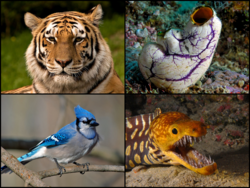Top Qs
Timeline
Chat
Perspective
Olfactores
Clade of animals comprising vertebrates and tunicates From Wikipedia, the free encyclopedia
Remove ads
Olfactores is a clade within the Chordata that comprises the Tunicata (Urochordata) and the Vertebrata[citation needed] (sometimes referred to as Craniata). Olfactores represent the overwhelming majority of the phylum Chordata, as the Cephalochordata are the only chordates not included in the clade. This clade is defined by a more advanced olfactory system which, in the immediate vertebrate generation, gave rise to nostrils.
Remove ads
Etymology
The name Olfactores comes from Latin *olfactores ("smellers," from purposive supine olfactum of olfacio, "to smell," with plural masculine agentive nominalizing suffix -tores), due to the development of pharyngeal respiratory and sensory functions, in contrast with cephalochordates such as the lancelet which lack a respiratory system and specialized sense organs.[3]
Olfactores hypothesis
The long-standing Euchordata hypothesis that Cephalochordata is a sister taxon to Craniata was once widely accepted,[4] likely influenced by significant tunicate morphological apomorphies from other chordates, with cephalochordates even being nicknamed ‘honorary vertebrates.’[5]
The name Olfactores was originally introduced in 1991 as part of the now-disproven calcichordate hypothesis.[6] However, studies since 2006 analyzing large sequencing datasets strongly support Olfactores as a clade.[7][8]
Studies suggest that the ancestors of Appendicularia and Vertebrata were possibly sedentary-pelagic.[9][10][11] A rudimentary neural crest is present in tunicates, implying its presence in the Olfactores ancestor also, as vertebrates have a true neural crest.[12]
Remove ads
References
Wikiwand - on
Seamless Wikipedia browsing. On steroids.
Remove ads

